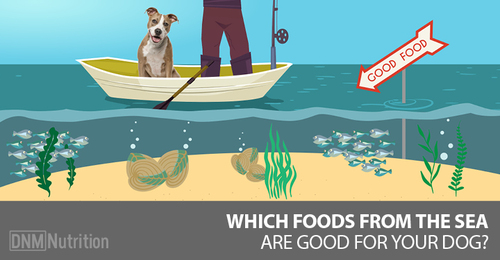

In general, fish that has been deboned, cleaned properly, and thoroughly cooked, is safe for canine consumption.
However, feeding your pooch high amounts of fish, regardless of how it's served, it can lead to thiamine deficiency.
Even if there was no ongoing debate about the benefits and healthiness of marine foods, the question remains: is it safe for a dog to eat fish, shrimp, or any other type of seafood?
The short answer is that dogs can eat some types of seafood, but it all depends on the species, and the method of preparation. Unsurprisingly, dogs do best with fish, whereas clams, shellfish, shrimps and other aquatic critters usually come with a set of warnings before serving.
Here are some general pointers as to what to look for in fish before you feed it to your furry baby:
Lifespan: Always go for shorter-lived species of fish. In species with longer lifespans, such as tuna, mackerel, or sea bass, high levels of heavy metals and toxins accumulate over their lifetime.
Size: The same rule applies when it comes to size. Smaller fish have less mercury, while bigger specimens tend to accumulate it, as they eat massive quantities of other fish.
Bones: Fish that are hard to clean of bones are a safety risk for dogs. Brittle bones can tear through your dog’s intestine wall and pose a choking hazard.
Of course, even with seafood and fish that are safe for dogs, moderation is key. While your pooch might benefit from an occasional meal, this type of food shouldn’t make up most of their diet.
Considering how much attention you need to pay to when choosing safe seafood for dogs, you might give up on the idea altogether. However, fish and seafood should be included in your pooch’s meals, at least from time to time, because of the benefits these foods offer:
Omega-3 fatty acids
High protein levels
Low levels of fat
Excellent alternative for dogs with allergies (to other protein sources)
Risks of Feeding Seafood to Dogs
In some cases, the risks can outweigh the benefits. Not all seafood is rich in nutrients needed in a dog’s diet, and some of them can even be harmful to your pooch.
Presence of toxins, heavy metals, and other pollutants
Commercial pet foods with fish can contain harmful preservatives
Risk of contracting bacteria such as salmonella and listeria (if raw or not cooked properly)
Although dogs can eat seafood and fish, it’s essential to prepare it adequately and choose the right type of seafood. If you’re unsure what seafood exactly can you feed your dog, check out the two lists below:
Cooked Fish
In general, fish that has been deboned, cleaned properly, and thoroughly cooked, is safe for canine consumption.
However, feeding your pooch high amounts of fish, regardless of how it’s served, it can lead to thiamine deficiency.
Thiamine deficiency can have severe consequences for your pet’s health and even lead to death in more extreme cases.
Raw Fish
Uncooked fish is rich in nutrients and often appetizing to dogs, but it can also contain flukes, tapeworms, or roundworms. Apart from cleaning it, you should freeze raw fish for a few weeks before feeding it to your pooch, to eliminate any potential of nasty parasites hiding about. When you want to serve your furball’s meal, just thaw it, and you’re ready to go!
Salmon (Cooked)
Boneless salmon fillets are considered a premium meal for any pooch, but only if the salmon wasn’t farmed. Cooked salmon is a quality source of essential fatty acids and proteins, and you can include it in your dog’s diet without having to worry about long-term side effects. Just make sure not to feed it to your dog more than once or twice a week, and follow portion recommendations.
Sardines
These small fish are often referred to as the healthiest fish in the sea, as they eat only planktons and don’t live long, which means that their exposure to heavy metals and toxins is minimal. Feed them raw, cooked, or canned in water. Don’t let the tiny size of these fish fool you: they pack quite a punch when it comes to nutritional values, so be careful with the portions, especially with chubby pups.
Herring and Anchovies
Little they may be, but these types of fish are very rich in omega-3 acids. Herring and anchovies are great additions to a dog’s diet, but only if served raw or cooked. Smoked, pickled, or salted fish is not recommended, as it contains other ingredients that might harm your pooch.
Krill Oil
Some people avoid giving fish to their dogs, whether because of the hassle or because they can’t find trusted sellers in their area. But, canines still need fatty acids, and the easiest way to introduce it to their diet is supplementing their meals with a tablespoon or two of oils rich in omega-3. Krill oil is a popular alternative to fish oil because it contains all the nutrients without the risk of toxins. It is made of minuscule crustaceans and a good source of fatty acids.
Seaweed
Same as with humans, seaweed is considered something of a superfood. Different types of seaweeds come in various forms, but in most cases, it is in dried sheets or powder. Sprinkle a little of this mineral and vitamin-rich food in your dog’s bowl to reap the benefits!
4 years ago by Angela Vuckovic
Good Health for People
